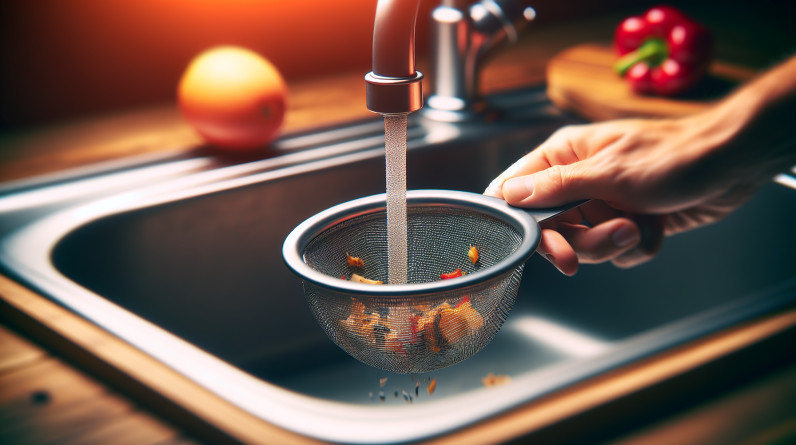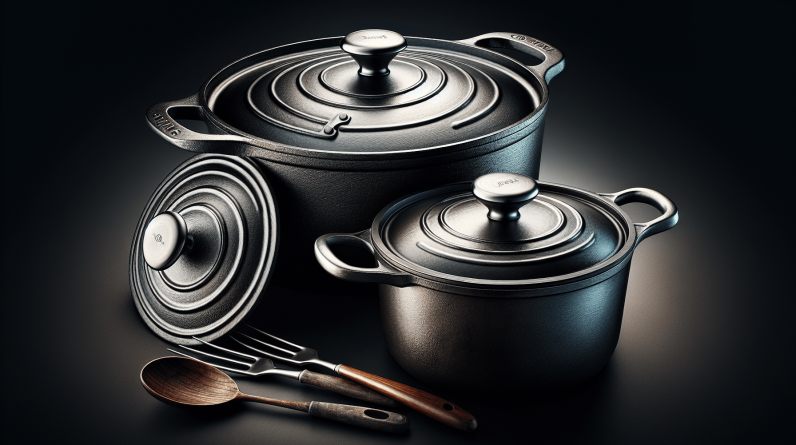Ensuring the safety of elderly members in our family is of paramount importance, particularly when it comes to the kitchen, a place that can pose multiple risks. From slippery floors to sharp utensils, it is crucial to take necessary steps to create a safe and accessible environment for our loved ones. In this article, we will explore practical and effective methods to make our kitchen a haven for the elderly, promoting their independence and well-being. By implementing these simple yet significant changes, we can ensure that our elderly family members can enjoy their time in the kitchen without any worries or hazards.

General Layout and Design
Clearing clutter
In order to create a safe and accessible kitchen for elderly members of the family, it is important to start with decluttering the space. Remove any unnecessary items from countertops, cabinets, and drawers to eliminate potential hazards and create a clean and organized environment.
Easy-to-reach storage
Consider installing easy-to-reach storage solutions in your kitchen to ensure that elderly family members can access items without straining or reaching too high. Lower shelves and pull-out drawers can be particularly helpful in this regard, allowing for easier access to frequently used items without the need to bend or stretch.
Proper lighting
Proper lighting is essential for ensuring the safety of elderly individuals in the kitchen. Make sure that the kitchen is well-lit with bright, evenly distributed lighting. Consider installing additional lighting fixtures or using natural light sources to illuminate work areas, countertops, and appliances. This will help prevent accidents and promote visibility while cooking or performing other tasks.
Non-slip flooring
When it comes to kitchen flooring, opt for non-slip options to reduce the risk of slips and falls. Choose materials that provide good traction, such as non-slip tiles, rubber flooring, or textured surfaces. These flooring options can help prevent accidents, especially in areas prone to getting wet, such as near sinks or dishwashers.
Appliances and Tools
Ergonomic appliances
Investing in ergonomic appliances can greatly enhance the safety and usability of the kitchen for elderly family members. Look for appliances with easy-to-read controls, large knobs or buttons, and clear labeling. Additionally, appliances with adjustable heights and user-friendly features can minimize strain and discomfort for elderly individuals while using them.
Easy-to-use tools
Opt for kitchen tools and utensils that are easy to use and manipulate for elderly family members. Look for utensils with ergonomic handles that provide a comfortable grip and are easy to handle. Consider lightweight cutting boards and utensils that require minimal pressure to use, reducing the risk of strain or injury.
Safety devices for cooking appliances
Installing safety devices for cooking appliances can provide an additional layer of protection in the kitchen. Consider adding stove knob covers to prevent accidental turning of the burners, especially when not in use. Additionally, automatic shut-off devices can be installed on stoves to reduce the risk of leaving burners on unintentionally.
Safety Measures for Cooking
Fire prevention
Fire prevention is crucial in any kitchen, especially when ensuring the safety of elderly family members. Keep flammable materials away from heat sources and make sure to regularly clean your oven and stovetop to prevent grease buildup. Avoid wearing loose clothing while cooking and never leave cooking unattended.
Stove safety
When it comes to stove safety, there are a few key measures to take. Ensure that the stove is properly maintained and always use the correct size of pots and pans. Use back burners whenever possible and turn handles inward to prevent accidental spills or burns. It is also recommended to install stove guards to create a barrier between the stovetop and any nearby individuals, reducing the risk of accidental contact with hot surfaces.
Microwave safety
Microwaves can be a convenient and efficient way to heat and cook food, but it’s important to follow proper safety measures. Make sure to use microwave-safe cookware and containers, as improper materials can cause fires or release harmful toxins. Avoid overloading the microwave and always use oven mitts or heat-resistant gloves when handling hot dishes.
Avoiding burns and scalds
To avoid burns and scalds in the kitchen, it is important to take precautions and practice safe handling techniques. Use oven mitts or heat-resistant gloves when handling hot pots, pans, or dishes. Take extra care when working with boiling liquids and always use pot holders or trivets on countertops to protect surfaces from hot cookware.
Safe Food Preparation
Organizing workspaces
Properly organizing workspaces can greatly enhance the safety and efficiency of food preparation for elderly individuals in the kitchen. Clear countertops of unnecessary items and organize essential tools and ingredients within easy reach. Create designated areas for prepping, cutting, and assembling ingredients, ensuring that all necessary tools and utensils are readily available.
Proper knife safety
Proper knife safety is essential for preventing accidents and injuries in the kitchen. Ensure that knives are sharp and well-maintained, as dull blades can be more difficult to control and increase the risk of slips. Always use a cutting board with a non-slip surface and consider using knives with ergonomic handles that provide a comfortable and secure grip.
Preventing cross-contamination
Preventing cross-contamination is crucial when it comes to safe food preparation. Encourage elderly family members to practice proper food handling techniques, such as separating raw meats from other ingredients and using separate cutting boards for different types of foods. Regularly sanitize cutting boards, utensils, and countertops to minimize the risk of bacterial growth and foodborne illnesses.
Electric appliances for tasks
Incorporating electric appliances can simplify and enhance the food preparation process for elderly individuals. Consider using electric can openers, food processors, or electric knives to minimize the need for manual dexterity or excessive force. These appliances can make food preparation tasks easier and safer for those with limited mobility or strength.

Accessible Storage and Organization
Lower shelves and pull-out drawers
Installing lower shelves and pull-out drawers can greatly improve the accessibility of storage areas for elderly family members. This allows them to reach items without straining or requiring assistance. Consider incorporating adjustable shelving or pull-out organizers to maximize flexibility and ease of use.
Clear labeling and color coding
Clear labeling and color coding can help elderly individuals easily identify and locate items in the kitchen. Use large, bold labels with high contrast colors to make them more visible. You can also consider color-coding specific areas or categories, such as blue for cooking utensils and yellow for baking supplies, to further enhance organization and ease of use.
Accessible pantry solutions
Incorporating accessible pantry solutions can make it easier for elderly family members to store and retrieve items. Avoid using high shelves that require reaching or step-stools. Instead, utilize lower shelves or install sliding shelves or pull-out baskets to improve accessibility. Consider using clear, stackable containers for storing dry goods to make it easier to see and access items.
Flooring and Other Surfaces
Non-slip flooring options
Choosing non-slip flooring options is essential for minimizing the risk of slips and falls in the kitchen. Opt for materials such as non-slip tiles, rubber flooring, or textured surfaces that provide good traction, even when wet. Avoid glossy or polished surfaces that can become slippery.
Avoiding tripping hazards
To ensure a safe kitchen environment for elderly individuals, it is important to avoid tripping hazards. Keep electrical cords or loose rugs secured and out of walkways. Make sure that any transitions between flooring surfaces are smooth and level to prevent trips or stumbles. Remove any obstacles or clutter from the floor to maintain a clear pathway.
Easy-to-clean surfaces
Choose easy-to-clean surfaces in your kitchen to make maintenance and hygiene more manageable for elderly family members. Opt for materials that are resistant to stains and spills, such as quartz or laminate countertops. Additionally, select flooring options that are easy to sweep or mop, reducing the risk of dirt or spills causing a hazard.

Adequate Seating and Support
Comfortable seating
Providing adequate seating is crucial for elderly individuals who may require breaks or have limited mobility. Choose comfortable seating options with proper back support and cushioning. Consider installing adjustable height chairs or stools that can accommodate different individuals’ needs.
Handrails and grab bars
Installing handrails and grab bars in the kitchen can offer additional support and stability for elderly family members. Consider adding them near high-traffic areas, such as by the stove or sink, to provide assistance when needed. Ensure that handrails and grab bars are securely mounted and can bear the weight of an individual.
Raised countertops
To accommodate individuals who require wheelchair accessibility or have difficulty bending over, consider installing raised countertops in the kitchen. Raised countertops can provide a comfortable and convenient work surface, allowing elderly family members to prepare food or perform tasks without straining their backs or joints.
Safety Considerations for Utensils and Cookware
Ergonomic utensils and handles
Choosing ergonomic utensils and handles can greatly enhance the safety and ease of use for elderly individuals in the kitchen. Look for utensils with larger, easy-grip handles that provide better control and reduce the risk of slipping. Similarly, opt for lightweight and balanced utensils to minimize strain and increase comfort during use.
Non-slip cookware
Investing in non-slip cookware can significantly reduce the risk of accidents and injuries in the kitchen. Choose pots, pans, and baking dishes with non-slip bottoms to prevent them from sliding or tipping over on stovetops or countertops. Additionally, consider utilizing silicon grips or handles on cookware to enhance grip and minimize the risk of burns or spills.
Avoiding heavy items
In order to minimize strain and the risk of injury, it is important to avoid heavy items in the kitchen. Encourage elderly family members to use lightweight cookware, plates, and utensils. Opt for smaller portion sizes or divide heavy items into multiple, more manageable containers for easier handling.
Fire Safety and Extinguishers
Placing fire extinguishers
Ensuring that fire extinguishers are readily available in the kitchen is an essential safety measure. Place fire extinguishers in easily accessible locations and ensure that everyone in the household knows how to use them. Regularly check the expiration dates on fire extinguishers and replace them as needed.
Safety tips for using extinguishers
In the event of a fire, it is crucial to know how to use a fire extinguisher safely and effectively. Remember the acronym “PASS” – Pull the pin, Aim at the base of the fire, Squeeze the handle, and Sweep from side to side. Always aim at the base of the fire to cut off its oxygen supply and work in a sweeping motion to extinguish the flames.
Emergency Communication and Access
Emergency phone numbers
Having emergency phone numbers readily available in the kitchen is essential for quick and efficient access to help during an emergency situation. Keep a list of important numbers, such as emergency services, local hospitals, and poison control, in a visible and easily accessible location. Consider placing this information on the refrigerator or near a phone for easy reference.
Easy access to emergency kits
In case of emergencies, it is important to have easy access to emergency kits in the kitchen. Stock your kitchen with a well-equipped first aid kit and keep it in a designated area that is easily accessible. Additionally, consider having a basic emergency preparedness kit nearby that includes essentials such as flashlight, batteries, and non-perishable food items.
By implementing these comprehensive safety measures in your kitchen, you can create a safe and accessible environment for elderly family members. Taking the time to address these specific areas, from general layout and design to safe food preparation, will ensure that the kitchen is a welcoming and secure space for individuals of all ages. Remember to always prioritize the well-being and safety of your loved ones when designing and organizing your kitchen.










